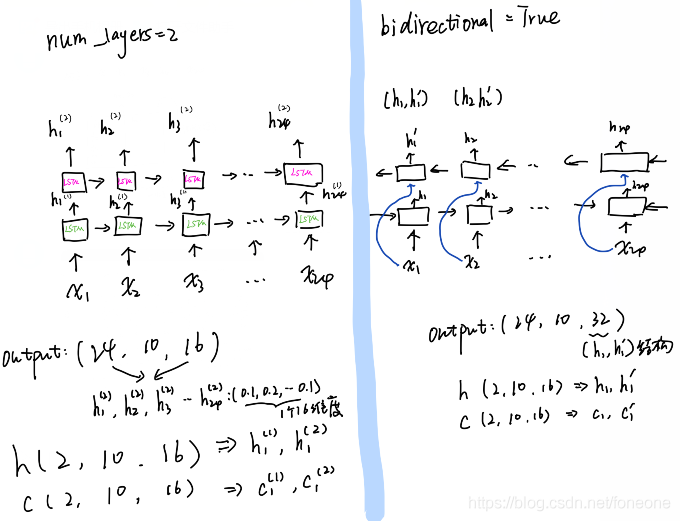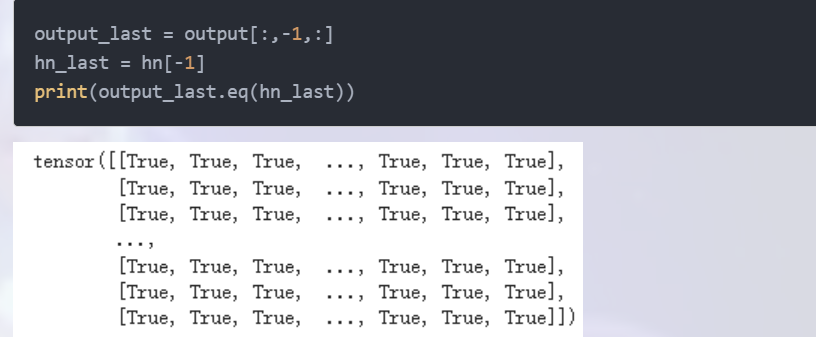torch.nn中的网络模型介绍
一、torch.nn.Linear
torch.nn.Linear(in_features,out_features,bias=True)
nn.linear()是用来设置网络中的全连接层的,也可以说是线性映射,这里面没有激活函数。而在全连接层中的输入与输出都是二维张量,输入输出的形状为[batch_size, size]
import torch from IPython.core.interactiveshell import InteractiveShell InteractiveShell.ast_node_interactivity='all' #输入=【128,20】,128个样本,维度20 x = torch.randn(128, 20) #通过全连接做线性变换,从20维转化为30维度 m = torch.nn.Linear(20, 30) # 20,30是指维度 #输出的size=【128,30】,128个样本,每个样本维度30 output = m(x) output.shape m.weight.shape m.bias.shape
torch.Size([128, 30])
torch.Size([30, 20])
torch.Size([30])
二、torch.nn.LSTM
input_size :输入的维度
hidden_size:h的维度
num_layers:堆叠LSTM的层数,默认值为1,这里的层数表示是单层还是双层的
bias:偏置 ,默认值:True
batch_first: 如果是True,则input为(batch, seq, input_size)。默认值为:False(seq_len, batch, input_size)
bidirectional :是否双向传播,默认值为False
以训练句子为例子,假如每个词是100维的向量,每个句子含有24个单词,一次训练10个句子。那么batch_size=10,seq=24,input_size=100。(seq指的是句子的长度,input_size作为一个的输入) ,所以在设置LSTM网络的过程中input_size=100。由于seq的长度是24,那么这个LSTM结构会循环24次最后输出预设的结果,所以如果是单层的lstm,其实就是一个lstm循环seq次,如果是num_layers=2,就是上下两层lstm循环seq次。
(num_layers,bidirectional),两个的结构的区别如下图所示:

输出:
output :(seq_len,batch_size, num_directions * hidden_size)
h_n:(num_layers * num_directions, batch, hidden_size)
c_n :(num_layers * num_directions, batch, hidden_size)
output:保存了每个时间步的输出,如果想要获取最后一个时间步的输出,则可以这么获取:output_last = output[:,-1,:]
h_n:包含的是句子的最后一个单词的隐藏状态,与句子的长度seq_length无关
c_n:包含的是句子的最后一个单词的细胞状态,与句子的长度seq_length无关
另外:最后一个时间步的输出等于最后一个隐含层的输出:

import torch.nn as nn import torch #seq=24,batch=10,input_size=100 x = torch.rand(24,10,100) #input_size=100,hide_size=16 lstm = nn.LSTM(100,16,num_layers=2) #结果输出 output,(h,c) = lstm(x) print(output.size()) print(h.size()) print(c.size()) output:
#这个表示的是最终10个长度为24的句子的最终的输出 torch.Size([24, 10, 16]) #因为是上下两层的lstm,所以有两组h和c torch.Size([2, 10, 16]) torch.Size([2, 10, 16])
如果设置为batch_first=True,就代表输入中第一个是batch_size,最后输出也会变化了,如下:
import torch.nn as nn import torch #batch=10,seq=24,input_size=100 x = torch.rand(24,10,100) #input_size=100,hide_size=16 lstm = nn.LSTM(100,16,num_layers=2,batch_first=True) #结果输出 output,(h,c) = lstm(x) print(output.size()) print(h.size()) print(c.size()) OUT: torch.Size([24, 10, 16]) torch.Size([2, 24, 16]) torch.Size([2, 24, 16])
可以根据seq的长度一个一个步长的循环输入:
import torch import torch.nn as nn lstm = nn.LSTM(10, 20, 2) x = torch.randn(5, 3, 10) h0 = torch.randn(2, 3, 20) c0 = torch.randn(2, 3, 20) hn,cn=h0,c0 #可以根据seq的长度一个一个循环输入 for i in range(len(x)): #x[i]后就少了一个维度了,所以需要前面再加入一个维度unsqueeze(0) output, (hn, cn)=lstm(x[i].unsqueeze(0), (hn, cn)) print(output.shape)#这个时候output的输出就不是整体所有步长的了,而是一个一个步长的输出了。
OUT:
torch.Size([1, 3, 20]) torch.Size([1, 3, 20]) torch.Size([1, 3, 20]) torch.Size([1, 3, 20]) torch.Size([1, 3, 20])
三、torch.nn.Conv1d
class torch.nn.Conv1d(in_channels, out_channels, kernel_size,stride=1, padding=0, dilation=1, groups=1, bias=True)
in_channels(int)—输入数据的通道数。在文本分类中,即为句子中单个词的词向量的维度。 (word_vector_num)
out_channels(int)—输出数据的通道数。设置 N 个输出通道数,就有 N 个1维卷积核。(new word_vector_num)
kernel_size(int or tuple) —卷积核的长度,1维卷积中卷积核的实际大小维度是(in_channels,kernel_size),顺序不可互换。
stride(int or tuple, optional)—卷积步长,步长就是一次卷积核移动多元,可以移动2步,也可以一步步移动。
padding (int or tuple, optional)—输入的每一条边补充0的层数。
dilation(int or tuple, `optional``)—卷积核元素之间的间距。
groups(int, optional)—从输入通道到输出通道的阻塞连接数。
bias(bool, optional)—如果bias=True,添加偏置。
举例:
import torch as t input = t.randn(6,5,3) # batch_size= 6(sentence_num), sentence_word_num= 5, word_vector_num = 3 print(input) print(input.shape) # [6,5,3] input = input.permute(0,2,1) # 维度转换(sentence_word_num <-> word_vector_num) print(input) print(input.shape) # [6,3,5] conv1 = nn.Conv1d(3, 8, 2, bias=False) # in_channels = word_vector_num = 3,out_channels = 8(new word_vector_num), kernel_size = 2 print(conv1.weight.shape) # [8,3,2] output = conv1(input) print(output) print(output.shape) # [6,8,4]
详细参考:https://blog.csdn.net/rothschild666/article/details/124127319
Conv1d&kernel_size=1和nn.linear()有什么不同呢?
import torch import torch.nn as nn import torch.nn.functional as F x = torch.randn(1, 100, 3) # 创建一个batch_size=1的点云,长度100 layer = nn.Linear(3, 10) # 构造一个输入节点为3,输出节点为10的网络层 y = F.sigmoid(layer(x)) # 计算y,sigmoid激活函数 print(x.size()) print(y.size()) ''' >>>torch.Size([1, 100, 3]) >>>torch.Size([1, 100, 10])
换成Conv1d来看看:
import torch import torch.nn as nn import torch.nn.functional as F #先进行了转置 x = torch.randn(1, 3, 100) # 创建一个batch_size=1的点云,长度100 layer = nn.Conv1d(3, 10, kernel_size=1) # 构造一个输入节点为3,输出节点为10的网络层 y = F.sigmoid(layer(x)) # 计算y,sigmoid激活函数 print(x.size()) print(y.size()) ''' >>>torch.Size([1, 3, 100]) >>>torch.Size([1, 10, 100])#若要结果与线性变换一直,可以最后对结果再转置回来。
1、nn.Conv1d输入的是一个[batch, channel, length],3维tensor,而nn.Linear输入的是一个[batch, *, in_features],可变形状tensor,在进行等价计算时务必保证nn.Linear输入tensor为三维
2、nn.Conv1d作用在第二个维度位置channel,nn.Linear作用在第三个维度位置in_features,对于一个 X X X,若要在两者之间进行等价计算,需要进行tensor.permute,重新排列维度轴秩序,这种情况下如果参数也是一致的,其计算结果就是一样的。
验证nn.Conv1d, kernel_size=1与nn.Linear计算结果相同
import torch def count_parameters(model): """Count the number of parameters in a model.""" return sum([p.numel() for p in model.parameters()]) conv = torch.nn.Conv1d(8,32,1) print(count_parameters(conv)) # 288 linear = torch.nn.Linear(8,32) print(count_parameters(linear)) # 288 print(conv.weight.shape) # torch.Size([32, 8, 1]) print(linear.weight.shape) # torch.Size([32, 8]) # use same initialization linear.weight = torch.nn.Parameter(conv.weight.squeeze(2)) linear.bias = torch.nn.Parameter(conv.bias) tensor = torch.randn(128,256,8) permuted_tensor = tensor.permute(0,2,1).clone().contiguous() # 注意此处进行了维度重新排列 out_linear = linear(tensor) print(out_linear.mean()) # tensor(0.0067, grad_fn=<MeanBackward0>) out_conv = conv(permuted_tensor) print(out_conv.mean()) # tensor(0.0067, grad_fn=<MeanBackward0>)




 浙公网安备 33010602011771号
浙公网安备 33010602011771号